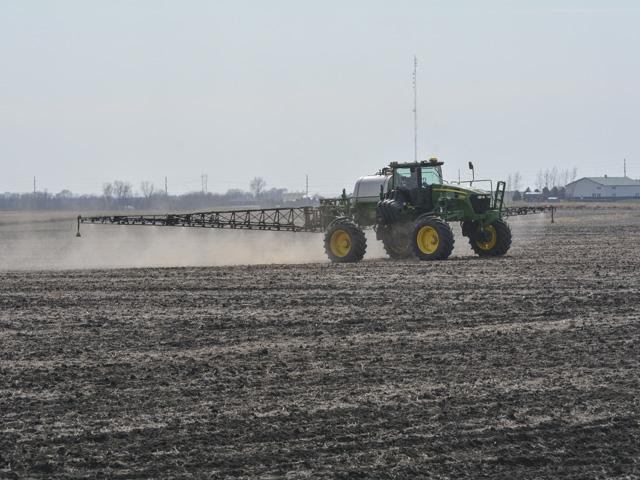Prevent Weeds From Stealing Corn Yields
Four Tips to Keep Weeds From Stealing Nutrients and Yields
NEW ORLEANS (DTN) -- Don't let young weeds steal expensive nutrients and reduce corn yields. Improving fertilizer efficiency through better weed control is one way to bolster profit potential.
Weed specialists urge farmers who haven't adopted an aggressive, early season herbicide program that includes pre- and post-emergence applications with residual control to do so. Shawn Hock, Syngenta herbicide product lead, said there are many growers in the Corn Belt that rely on tillage and one, or maybe two, post-emergence herbicide applications to control weeds.
Hock said weeds will often grow after fields are tilled and start to rob nutrients and water from young corn plants before they're killed with a post-emergence herbicide application, which reduces yields. That strategy needs to change, he said at Syngenta's Media Summit in New Orleans, held Oct. 31-Nov. 2.
"It's time to rethink weed control strategies that don't work," he continued. "What we're really talking about is simple; use effective and safe pre-emergence herbicides."
Here are Hock's weed-control recommendations:
1. Multiple herbicide applications, including pre- and post-emergence. Use herbicides with multiple sites of action and residual control. "If you only do one pass, you're putting all your eggs in one basket."
2. Herbicide application timing is critical. Watch weather forecasts since activating rainfall is often needed within seven to 14 days of spraying.
3. Increase herbicide rates as needed, but follow label instructions. Herbicide labeled rates have a range. Work with a trusted adviser/agronomist to decide what rate is needed.
4, In drought areas, weed seed banks likely increased. Be mindful that tillage may cause more weeds to germinate in the spring.
P[L1] D[0x0] M[300x250] OOP[F] ADUNIT[] T[]
"Our main message is save your fertilizer investment for the crop, not the weeds," Hock said. Better early season weed control "maximizes the growth and development of corn plants."
Watch a video of Hock discussing weed control at www.dtnpf.com/agriculture/web/ag/videos/special-reports?embedCode=ags2022x10&channelTab=Special%20Reports.
Matt Moreland, owner of Moreland Farms in north-central Oklahoma and southern Kansas, said herbicide-resistant Palmer amaranth is a threat to his corn, soybean, winter wheat and cotton operation. He stacks pre-emergence residual herbicides to control the vile weed.
"We can't let them emerge," he said. "As soon as pigweeds (Palmer) emerges, you think you can get them, and then a weather event changes things. Some active ingredients won't kill them all."
WEED RESEARCH
Syngenta Crop Protection research shows young weeds deprive corn of needed nutrients. Hock said a past multi-year study at 20 research locations proves that early season weed control pays.
Two- to 4-inch weeds consume, on a per-acre basis, 13.5 pounds of nitrogen (N), 0.85 pound of phosphorus and 16.8 pounds of potassium, according to the study. The nutrient loss equals about $24 per acre based on recent prices, Hock said.
"That $24 per acre could be used for a really strong pre-emergence (herbicide) program. Farmers need to manage weeds earlier," he added.
With fertilizer prices near all-time highs -- find the latest DTN fertilizer price trend story at www.dtnpf.com/agriculture/web/ag/news/article/2022/11/09/fertilizer-prices-continue-slump -- Hock said it's imperative farmers do what they can to increase yields and improve profit potential.
If young weeds utilize 13.5 pounds of N intended for corn, Hock said that can reduce corn yields by about 16 bushels per acre based on nitrogen-use efficiency of today's hybrids. Many only need 0.8 pound of nitrogen to produce 1 bushel of corn, he continued.
"There's opportunities for potential record profits in some cases," Hock said. "But (farmers) have to have the production and make the right decisions at the right time."
HUNGRY WEEDS
Michigan State University (MSU) studied nutrient consumption of weeds from 2009-2011. Researchers found that 2-inch-tall weeds in corn at the V3 growth stage consumed between 7 to 16.4 pounds of N per acre at several N application rates (60, 120 and 180 pounds of N per acre). As corn and weeds grew, the more N weeds would consume. Weed N consumption also increased with higher N application rates.
Find MSU data at https://d.lib.msu.edu/….
Although there was no correlation in the MSU study to N assimilation by weeds with corn grain yield, MSU Assitant Professor Erin Burns, specializing in integrated weed management, said there's no question that small weeds curtail yields. Several reasons include being an impediment at planting, hindering corn emergence, possibly reducing stand, serving as a host for damaging pathogens and insects, and stealing N, water and sunlight.
Burns said multiple pre- and post-emergence herbicide applications, using multiple sites of action and residual control, are part of the future of weed control.
"Early season weeds are the largest yield robbers compared to ones that emerge later in the season," Burns said. "If you don't put down an effective pre-emergence product with a residual, there's potentially yield potential already taken away. As weeds grow, they're harder to control."
Matthew Wilde can be reached at matt.wilde@dtn.com
Follow him on Twitter @progressivwilde
(c) Copyright 2022 DTN, LLC. All rights reserved.






